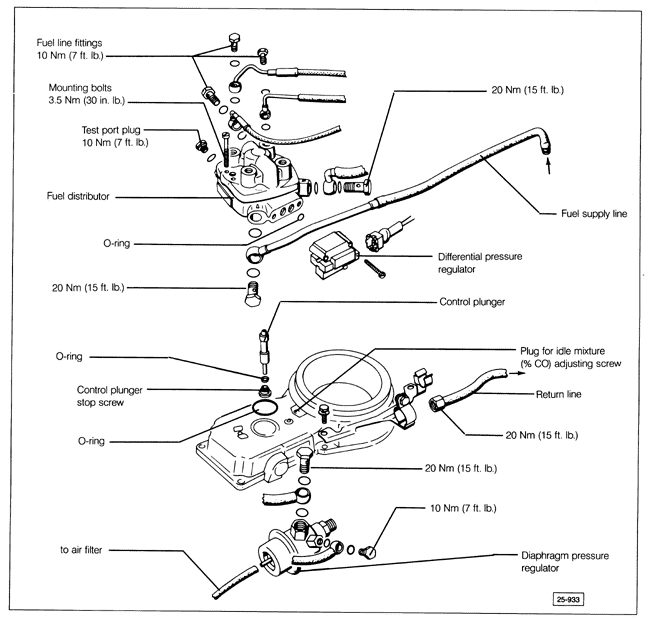Residual PressureThe fuel system is designed to maintain pressure for a time after the engine is shut off to help prevent overheating fuel in the injector lines from vapor locking and causing hard starting. The fuel pump's one-way check valve and the fuel accumulator help maintain this residual pressure. See 4. Fuel Supply. When troubleshooting hot-start problems, check residual pressure with the pressure gauge connected as described above and the gauge valve open. Pressurize the fuel system by bypassing the fuel pump relay to operate the pump, as described in 4.1 Fuses and Relays. Run the pump for several seconds until the pressure reading stabilizes, then shut off the pump. The system should maintain pressure according to the specifications listed in Table m. Table m. Residual Pressure Specifications (CIS-E and CIS-E Motronic)
If pressure drops too quickly, check for leaks in the fuel lines, the fuel distributor O-rings, and the injectors. If no leaks are found, the most likely cause is a faulty fuel pump check valve. Check the check valve and the fuel accumulator as described below. Another possible cause, though less likely, is incorrect air flow sensor plate clearance. See 6.1 Air Flow Measurement and Fuel Metering.

To check the fuel pump check valve and the fuel accumulator, check residual pressure at the fuel supply line from the pump. See Fig. 6-15, shown earlier. Connect the pressure gauge to the fuel supply line coming from the pump.
Run the fuel pump by bypassing the relay until fuel pressure indicated by the gauge reaches 5 bar (78 psi). Then turn the fuel pump off. Once again, the system should maintain pressure according to the specifications listed in Table m above. If the pressure still drops excessively and no leaks are found between the fuel pump and the gauge, repeat the test. This time shut off the pump and immediately pinch closed the fuel hose between the tank and the pump. If residual pressure now stays within specifications, the fuel pump check valve is faulty and should be replaced. See 4.3 Fuel Pump. If the residual pressure still drops off too quickly, the fuel accumulator may be faulty. For a quick check, remove the plug from the end of the accumulator. If fuel drips out, then the diaphragm is leaking and the accumulator should be replaced. |
